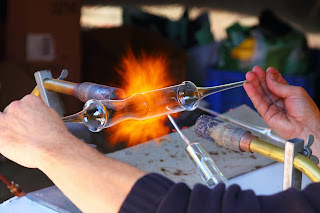Kirchhoff's Law of Heat radiation
Introduction : Kirchhoff studied the behaviour of heat radiation and based on that result obtained from emissive power and absorptive power he made a understanding that radiation depends on wavelength specific radiative emission and absorption by a body in thermal equilibrium. Note: All body when heated emits the same kind of radiation which they absorbs. Thus Kirchhoff arrived at an conclusion known as kirchhoff's law of heat radiation.
Kirchhoff's law of heat : The coefficient of emission is always equal to coefficient of absorption at any given temperature.
Mathematically,
a = e -------(1)
but we know that e = E / Eb -------(2)
From (1) & (2)
a = E / Eb
E / a = Eb -------(3)
From equation no (3) Kirchhoff's law can be defined as At any temperature, the ratio of the emissive power(E) to the coefficient of absorption(a) is always equal to emissive power of a perfectly black body (Eb ) at the same temperature.
Theoretical proff of Kirchhoff's law
Consider a thermally isolated system which can be considered as uniform temperature enclosure. Two body A which is ordinary and body B which is perfectly black body have emissive power E and Eb respectively. Let body A has coefficient of emission (e) and coefficient of absorption (a). Both the body have same area and let Q be the amount of radiant heat incident on both the body in a given time and thus heat radiation absorbed by the body A is given by ,
Qa = a Q ---------(4) [Qa / Q = a]
Qa = Radiant heat absorbed by the body
a = Coefficient of absorption
Q = Total heat incident
Thus we know that,
Heat absorbed by the body = Heat emitted by the body
a Q = E -----(5)
For perfectly black body the heat radiation absorbed is given by,
Qa = a Q
( for perfectly black body a= 1)
Qa = Q
Thus we know that ,
Heat absorbed by the perfectly black body = Heat emitted by the body
Q = Eb -----(6)
from (5) and (6) dividing
a = E / Eb
Hence proved









































